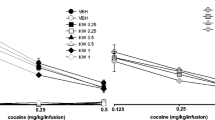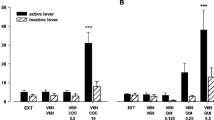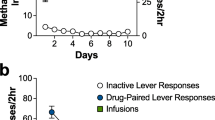Abstract
Rationale
Caffeine is a non-selective adenosine receptor antagonist in vitro, but involvement of different adenosine receptor subtypes, particularly adenosine A1 and A2A receptors, in the central effects of caffeine remains a matter of debate.
Objective
Investigate the role of adenosine A1 and A2A receptors in the discriminative-stimulus effects of caffeine.
Methods
Rats were trained to discriminate an injection of 30 mg/kg (i.p.) caffeine from saline. The selective A1 receptor antagonist CPT, the selective A2A receptor antagonist MSX-3 and the non-selective adenosine receptor antagonist DMPX were assessed for their ability to produce caffeine-like discriminative effects. The ability of CPT, MSX-3, the A1 receptor agonist CPA and the A2A receptor agonist CGS21680 to reduce the discriminative effects of caffeine was also tested. Radioligand binding experiments with membrane preparations from rat striatum and transfected mammalian cell lines were performed to characterize binding affinity profiles of the different adenosine antagonists used in the present study (caffeine, DMPX, CPT and MSX-3) in relation to all known adenosine receptors (A1, A2A, A2B, A3).
Results
DMPX and CPT, but not MSX-3, produced significant caffeine-like discriminative effects. MSX-3, but not CPT, markedly reduced the discriminative effects of caffeine and the caffeine-like discriminative effects of CPT. Furthermore, the A1 receptor agonist CPA, but not the A2A agonist CGS21680, reduced caffeine’s discriminative effects.
Conclusions
Adenosine A1 receptor blockade is involved in the discriminative-stimulus effects of behaviorally relevant doses of caffeine; A2A receptor blockade does not play a central role in caffeine’s discriminative effects and counteracts the A1 receptor-mediated discriminative-stimulus effects of caffeine.






Similar content being viewed by others
References
Bruns RF, Lu GH, Pugsley TA (1986) Characterization of the A2 adenosine receptor labeled by [3H]NECA in rat striatal membranes. Mol Pharmacol 29:331–346
Daly JW, Fredholm BB (1998) Caffeine—an atypical drug of dependence. Drug Alcohol Depend 51:199–206
Evans SM, Critchfield TS, Griffiths RR (1994) Caffeine reinforcement demonstrated in a majority of moderate caffeine users. Behav Pharmacol 5:231–238
Ferré S, Fuxe K, von Euler G, Johansson B, Fredholm BB (1992) Adenosine–dopamine interactions in the brain. Neuroscience 51:501–512
Ferré S, Fredholm BB, Morelli M, Popoli P, Fuxe K (1997) Adenosine–dopamine receptor–receptor interactions as an integrative mechanism in the basal ganglia. Trends Neurosci 20:482–487
Fredholm BB, Bättig K, Holmén J, Nehlig A, Zvartau EE (1999) Actions of caffeine in the brain with special reference to factors that contribute to its widespread use. Pharmacol Rev 51:83–133
Fredholm BB, Irenius E, Kull B, Schulte G (2001) Comparison of the potency of adenosine as an agonist at human adenosine receptors expressed in Chinese hamster ovary cells. Biochem Pharmacol 61:443–448
Goldberg SR, Prada JA, Katz JL (1985) Stereoselective behavioral effects of N6-phenylisopropyl-adenosine and antagonism by caffeine. Psychopharmacology 87:272–277
Griffiths RR, Woodson PP (1988) Reinforcing properties of caffeine: studies in humans and laboratory animals. Pharmacol Biochem Behav 29:419–427
Griffiths RR, Bigelow GE, Liebson IA (1989) Reinforcing effects of caffeine in coffee and capsules. J Exp Anal Behav 52:127–140
Griffiths RR, Evans SM, Heishman SJ, Preston KL, Sannerud CA, Wolf B, Woodson PP (1990) Low-dose caffeine discrimination in humans. J Pharmacol Exp Ther 252:970–978
Hayallah AM, Sandoval-Ramírez J, Reith U, Schobert U, Preiss B, Schumacher B, Daly JW, Müller CE (2002) 1,8-Disubstituted xanthine derivatives: synthesis of potent A2B-selective adenosine receptor antagonists. J Med Chem 45:1500–1510
Holtzman SG (1986) Discriminative stimulus properties of caffeine in the rat: noradrenergic mediation. J Pharmacol Exp Ther 239:706–714
Jacobson KA, Nikodijevic O, Padgett WL, Gallo-Rodriguez C, Maillard M, Daly JW (1993) 8-(3-Chlorostyryl)caffeine (CSC) is a selective A2-adenosine antagonist in vitro and in vivo. FEBS Lett 323:141–144
Justinova Z, Ferre S, Segal PN, Antoniou K, Solinas M, Pappas LA, Highkin JL, Hockemeyer J, Munzar P, Goldberg SR (2003) Involvement of adenosine A1 and A2A receptors in the adenosinergic modulation of the discriminative-stimulus effects of cocaine and methamphetamine in rats. J Pharmacol Exp Ther 307:977–986
Kamien JB, Bickel WK, Hughes JR, Higgins ST, Smith BJ (1993) Drug discrimination by humans compared to nonhumans: current status and future directions. Psychopharmacology 111:259–270
Karcz-Kubicha M, Antoniou K, Terasmaa A, Quarta D, Solinas M, Justinova Z, Pezzola A, Reggio R, Muller E, Fuxe K, Goldberg R, Popoli P, Ferre S (2003) Involvement of adenosine A(1) and A(2A) receptors in the motor effects of caffeine after its acute and chronic administration. Neuropsychopharmacology 28:1281–1291
Kim SA, Marshall MA, Melman N, Kim HS, Müller CE, Linden J, Jacobson KA (2002) Structure–activity relationships at human and rat A2B adenosine receptors of xanthine derivatives substituted at the 1-, 3-, 7-, and 8-positions. J Med Chem 45(11):2131–2138
Ledent C, Vaugeois JM, Schiffmann SN, Pedrazzini T, El Yacoubi M, Vanderhaeghen JJ, Costentin J, Heath JK, Vassart G, Parmentier M (1997) Aggressiveness, hypoalgesia and high blood pressure in mice lacking the adenosine A2a receptor. Nature 388:674–678
Müller CE, Geis U, Hipp J, Schobert U, Frobenius W, Pawlowski M, Suzuki F, Sandoval-Ramirez J (1997) Synthesis and structure–activity relationships of 3,7-dimethyl-1-propargylxanthine derivatives, A2A-selective adenosine receptor antagonists. J Med Chem 40:4396–4405
Müller CE, Maurinsh J, Sauer R (2000) Binding of [3H]MSX-2 (3-(3-hydroxypropyl)-7-methyl-8-(m-methoxystyryl)-1-propargylxanthine) to rat striatal membranes—a new, selective antagonist radioligand for A2A adenosine receptors. Eur J Pharm Sci 10:259–265
Mumford GK, Holtzman SG (1991) Qualitative differences in the discriminative stimulus effects of low and high doses of caffeine in the rat. J Pharmacol Exp Ther 258:857–865
Nikodijevic O, Sarges R, Daly JW, Jacobson KA (1991) Behavioral effects of A1- and A2-selective adenosine agonists and antagonists: evidence for synergism and antagonism. J Pharmacol Exp Ther 259:286–294
Olah ME, Gallo-Rodriguez C, Jacobson KA, Stiles GA (1994) 125I-4-Aminobenzyl-5′-N-methylcarboxamidoadenosine, a high affinity radioligand for the rat A3 adenosine receptor. Mol Pharmacol 45:978–982
Powell KR, Koppelman LF, Holtzman SG (1999) Differential involvement of dopamine in mediating the discriminative stimulus effects of low and high doses of caffeine in rats. Behav Pharmacol 10:707–716
Quarta D, Ferré S, Solinas M, You Z-B, Hockemeyer J, Popoli P, Goldberg SR (2004) Opposite modulatory roles for adenosine A1 and A2A receptors on glutamate and dopamine release in the shell of the nucleus accumbens. Effects of chronic caffeine exposure. J Neurochem 88:1151–1158
Sauer R, Maurinsh J, Reith U, Fülle F, Klotz KN, Müller CE (2002) Water-soluble phosphate prodrugs of 1-propargyl-8-styrylxanthine derivatives, A2A-selective adenosine receptor antagonists. J Med Chem 43:440–448
Schuster CR, Johanson CE (1988) Relationship between the discriminative stimulus properties and subjective effects of drugs. Psychopharmacol Ser 4:161–175
Snyder SH, Katims JJ, Annau Z, Bruns RF, Daly JW (1981) Adenosine receptors and behavioral actions of methylxanthines. Proc Natl Acad Sci U S A 78:3260–3264
Solinas M, Ferré S, You ZB, Karcz-Kubicha M, Popoli P, Goldberg SR (2002) Caffeine induces dopamine and glutamate release in the shell of the nucleus accumbens. J Neurosci 22:6321–6324
van Galen PJ, van Bergen AH, Gallo-Rodriguez C, Melman N, Olah ME, Ijzerman AP, Stiles GL, Jacobson KA (1994) A binding site model and structure–activity relationships for the rat A3 adenosine receptor. Mol Pharmacol 45:1101–1111
Yamamoto T, Miyamoto K, Ueki S (1987) Rolipram as a discriminative stimuli: transfer to phosphodiesterase inhibitors. Jpn J Pharmacol 43:165–171
Yan L, Müller CE (2004) Preparation, properties, reactions, and adenosine receptor affinities of sulfophenylxanthine nitrophenyl esters: towards the development of sulfonic acid prodrugs with peroral bioavailability. J Med Chem 47(4):1031–1043
Acknowledgements
We thank Dr. Britta Schumacher, Dr. Martina Diekmann and Birgit Preiss for performing the radioligand binding assays.
Author information
Authors and Affiliations
Corresponding author
Rights and permissions
About this article
Cite this article
Solinas, M., Ferré, S., Antoniou, K. et al. Involvement of adenosine A1 receptors in the discriminative-stimulus effects of caffeine in rats. Psychopharmacology 179, 576–586 (2005). https://doi.org/10.1007/s00213-004-2081-6
Received:
Accepted:
Published:
Issue Date:
DOI: https://doi.org/10.1007/s00213-004-2081-6




